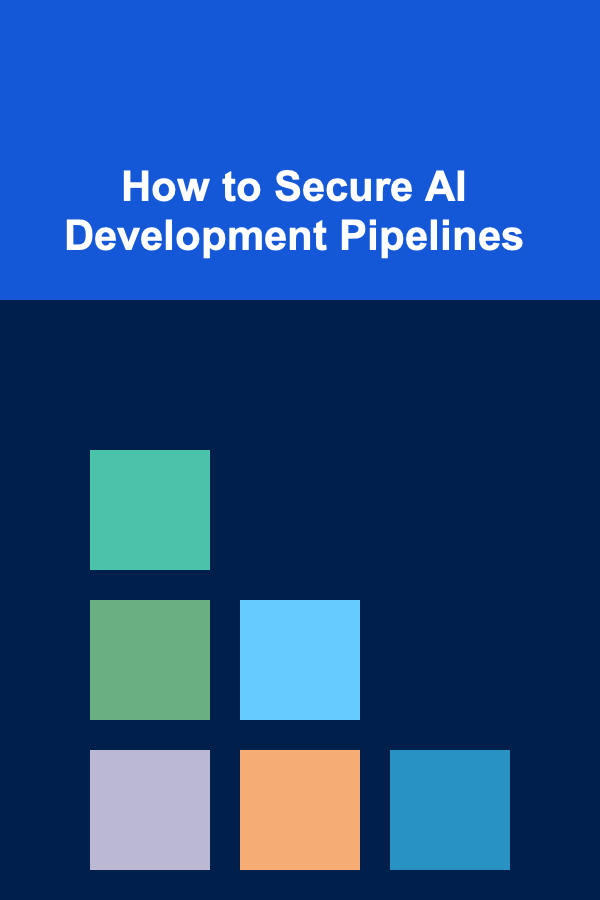
How to Secure AI Development Pipelines
ebook include PDF & Audio bundle (Micro Guide)
$12.99$7.99
Limited Time Offer! Order within the next:

Artificial Intelligence (AI) is rapidly reshaping industries, from healthcare and finance to manufacturing and retail. With AI's increasing influence comes the responsibility to ensure its safe, ethical, and secure deployment. One critical aspect of this is securing the AI development pipeline. The AI development pipeline is the entire process through which machine learning models are developed, tested, and deployed. Ensuring its security is essential not only to protect data but also to maintain trust in AI systems and avoid catastrophic failures. In this article, we will explore the different aspects of securing AI development pipelines and the best practices to implement at each stage of the development lifecycle.
Understanding the AI Development Pipeline
Before diving into the security aspects, it's essential to understand the components of an AI development pipeline. This pipeline typically includes:
- Data Collection: Gathering relevant data that the AI system will learn from.
- Data Preprocessing: Cleaning, transforming, and structuring the data to make it usable for training.
- Model Training: Using machine learning algorithms to create a model based on the training data.
- Model Evaluation: Testing the model's performance using validation and testing datasets.
- Model Deployment: Integrating the trained model into a production environment where it can make predictions.
- Monitoring and Maintenance: Continuously tracking the model's performance and updating it when necessary.
Each of these stages poses its own security challenges, which we will explore in detail in the following sections.
Securing the Data Collection Phase
The foundation of any AI system is its data. If the data is compromised or biased, the model built on it will inherit these issues. Securing the data collection phase is, therefore, the first and most crucial step.
1. Data Privacy and Compliance
AI systems often require access to large datasets, some of which might contain sensitive personal information. Ensuring that data collection complies with privacy regulations such as GDPR (General Data Protection Regulation) in Europe, HIPAA (Health Insurance Portability and Accountability Act) in the U.S., or CCPA (California Consumer Privacy Act) is essential.
Organizations must implement strict access controls to ensure that only authorized personnel have access to sensitive data. This includes:
- Data anonymization: Stripping personally identifiable information (PII) from datasets.
- Encryption: Encrypting sensitive data both at rest and in transit to ensure its confidentiality.
- Access control policies: Limiting data access to those who need it for specific tasks.
2. Data Provenance and Integrity
Data provenance refers to tracking the origin of data and ensuring its integrity. When data is collected from various sources, it is vital to ensure that the data hasn't been tampered with during its collection or transmission.
- Digital signatures: Use cryptographic methods to sign data and verify its source.
- Immutable logs: Maintain an immutable record of data access and modification to help detect unauthorized changes.
3. Securing Data Storage
Once data is collected, it needs to be securely stored. Implementing encryption and secure access controls is crucial in this phase. Additionally, organizations should:
- Use cloud storage services with built-in security features such as encryption at rest and multi-factor authentication (MFA).
- Regularly audit storage access and permissions to ensure only authorized users can access sensitive datasets.
Securing the Data Preprocessing Phase
Data preprocessing is another critical stage in the AI pipeline. This phase involves transforming raw data into a format that can be fed into machine learning models. However, it also opens up several security concerns.
1. Protecting Against Data Poisoning
Data poisoning occurs when malicious actors inject incorrect or malicious data into the training dataset with the intent of corrupting the model's learning process. In the data preprocessing phase, it's crucial to detect and eliminate poisoned data before it is used to train models.
- Anomaly detection: Implement anomaly detection systems to identify outliers in data that may indicate poisoning attempts.
- Data validation: Use automated tools to validate the consistency, quality, and source of data before it enters the preprocessing pipeline.
2. Secure Transformation Pipelines
When transforming data, especially when dealing with sensitive information, the transformation process should itself be secure. Implement secure data pipelines with proper logging and monitoring to ensure that data is not exposed or altered during transformation.
- Audit logs: Keep detailed logs of every operation performed during data transformation.
- Data masking: Mask or anonymize sensitive data during preprocessing to prevent unauthorized access to it.
Securing the Model Training Phase
The model training phase is where the magic happens, but it's also one of the most vulnerable parts of the AI pipeline. If the training environment or the training data is compromised, the resulting model could be biased, inaccurate, or even malicious.
1. Secure the Training Environment
The infrastructure used for training models should be secured to prevent unauthorized access. This includes:
- Network segmentation: Isolate the training environment from other parts of the network to prevent lateral movement by attackers.
- Access controls: Implement strict authentication mechanisms to control who can access the training environment.
- Virtualization and containerization: Use virtual machines or containers to isolate training environments, making it more difficult for attackers to compromise the system.
2. Model Watermarking
Model watermarking is a technique used to embed a unique, traceable mark in the model that can help identify if the model has been tampered with. This can act as a form of digital signature to ensure the integrity of the model.
- Invisible watermarks: Embed a watermark that does not affect the model's performance but can be used to prove ownership and authenticity.
- Auditable watermarks: Create watermarks that can be traced back to the original training process, making it easier to detect unauthorized versions of the model.
3. Defending Against Adversarial Attacks
Adversarial attacks involve subtly manipulating input data to deceive the AI model into making incorrect predictions. These attacks can lead to disastrous consequences if not addressed during training.
- Adversarial training: Train the model with adversarial examples to make it more robust against these attacks.
- Model regularization: Implement regularization techniques that reduce the model's sensitivity to small input variations.
Securing the Model Evaluation Phase
Once the model is trained, it undergoes an evaluation phase where its performance is tested against validation and test datasets. While this phase may seem less vulnerable to attacks, there are still several potential threats to be aware of.
1. Evaluation Data Integrity
The test datasets used for model evaluation must be carefully protected to ensure that the evaluation is accurate and unbiased. If the test data is compromised or manipulated, it could lead to false positives or negatives regarding the model's performance.
- Access control: Secure the test datasets to ensure only authorized users have access to them.
- Secure evaluation platforms: Use secure platforms for model evaluation to prevent tampering or unauthorized modifications.
2. Bias and Fairness Checks
During evaluation, it's also essential to test for biases in the model. If the model is trained on biased data, it may produce unfair or discriminatory results.
- Fairness auditing tools: Use tools to assess the fairness of the model and detect biases in its predictions.
- Diverse evaluation datasets: Ensure that the test data covers a wide range of scenarios to avoid bias toward specific groups or outcomes.
Securing the Model Deployment Phase
Once the model has been trained, evaluated, and validated, it is ready for deployment. However, deploying AI models into production environments introduces new risks, particularly around the exposure of the model to external threats.
1. Access Control and Authentication
When deploying AI models, it's essential to ensure that only authorized applications and users can interact with the model. This involves:
- API security: Use secure API gateways with authentication and rate-limiting to control access to the model.
- Role-based access control (RBAC): Implement RBAC to ensure that only authorized users can interact with the deployed model.
2. Monitoring and Anomaly Detection
Once the model is deployed, continuous monitoring is required to ensure that it is functioning as expected and to detect any unusual behavior that might indicate a security breach.
- Real-time monitoring: Set up real-time monitoring tools to track the model's performance and detect any anomalies.
- Automated anomaly detection: Use automated systems to alert administrators to any unexpected inputs or outputs from the model.
3. Model Versioning
Model versioning is crucial to ensure that you can roll back to a previous, secure version if something goes wrong with the deployed model. This can also help in tracking changes and auditing the model over time.
- Version control systems: Use version control to track model changes and ensure that only authorized versions are deployed.
- Model rollback: Implement mechanisms to roll back to a previous model version if necessary.
Securing the Monitoring and Maintenance Phase
Even after deployment, AI models require ongoing monitoring and maintenance to ensure that they remain secure and functional. This phase involves tracking the model's performance, retraining it with new data, and ensuring that it adapts to changing environments.
1. Continuous Model Monitoring
Regularly monitor the model's predictions and performance to ensure that it continues to operate correctly. This is especially important as models can degrade over time or become vulnerable to new types of adversarial attacks.
- Performance tracking: Set up systems to monitor the model's accuracy, fairness, and bias over time.
- Security patches: Regularly update the model with security patches to fix vulnerabilities.
2. Retraining with New Data
As new data becomes available, the model may need to be retrained to remain relevant. Retraining models with fresh data can also help to mitigate the risk of data drift or concept drift, where the distribution of data changes over time.
- Secure retraining pipelines: Ensure that the retraining process is as secure as the initial training process, including data validation and access controls.
- Continuous integration/continuous deployment (CI/CD): Use CI/CD practices to deploy new model versions securely and efficiently.
Conclusion
Securing AI development pipelines is a complex and ongoing process that requires attention to detail at every stage of the development lifecycle. By implementing strong data protection measures, securing the training environment, defending against adversarial attacks, and continuously monitoring the deployed model, organizations can build AI systems that are both secure and trustworthy. As AI continues to evolve, securing AI development pipelines will become even more critical in ensuring that AI systems are deployed safely and ethically, protecting both organizations and their users.
Reading More From Our Other Websites
- [Skydiving Tip 101] Best High‑Altitude Tandem Jumps Over Mountain Ranges for Adventure Photographers
- [Home Budget 101] How to Budget for Home Renovations Without Overspending
- [Rock Climbing Tip 101] Training Together: Joint Workouts and Drills to Boost Your Partner Climbing Performance
- [Home Storage Solution 101] How to Store Your Sports Gear Efficiently in Limited Space
- [Organization Tip 101] What Should You Know About Organizing Your Cleaning Supplies?
- [Home Cleaning 101] How to Clean Your Kid's Art and Craft Supplies
- [Organization Tip 101] How to Create a Holiday Decoration Inspiration Board
- [Organization Tip 101] How to Use Magnetic Spice Racks to Save Space
- [Home Lighting 101] How to Use Dimmer Switches to Create Versatile Lighting in Any Room
- [Needle Felting Tip 101] Choosing the Perfect Yarn and Tools for Needle-Felting a Dog

Creating Sustainable Passive Income with Deep Learning in SaaS
Read More
How to Set Up Automated Reminders for Employee Benefits Enrollment: An Actionable Guide
Read More
How to Understand Cultural Norms Around Gender
Read More
How to Use Hooks and Pegboards for Toy Storage
Read More
How to Bonsai Using Kokedama Techniques
Read More
10 Tips for Establishing a Consistent Bedtime Routine
Read MoreOther Products

Creating Sustainable Passive Income with Deep Learning in SaaS
Read More
How to Set Up Automated Reminders for Employee Benefits Enrollment: An Actionable Guide
Read More
How to Understand Cultural Norms Around Gender
Read More
How to Use Hooks and Pegboards for Toy Storage
Read More
How to Bonsai Using Kokedama Techniques
Read More